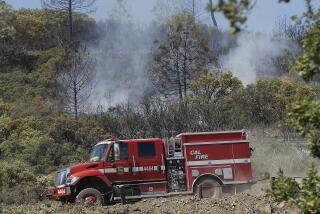In the Line of Fire, Inmates Earn Respect and Learn Teamwork
The Marple fire near Castaic may have been one of the season’s biggest, but Carolyn Steinhoff wasn’t impressed.
“This is a bad fire for me. It’s boring,” said Steinhoff, a California state prison inmate and firefighter who was taking a lunch break with fellow inmates in the blackened hills above Castaic Lake this weekend.
For Steinhoff, 27, a “good fire” is one like the California 58 blaze earlier this season on which she and her crew worked for 36 hours at a stretch, delirious on their feet. “You get a rush from it,” she said. “You even don’t feel the heat.”
Steinhoff, a peppy former drug dealer, is one of 564 state prison inmates fighting the Castaic fire.
The inmates comprise one-fourth of all the firefighters deployed on the blaze, which has charred 21,500 acres since it was started, allegedly by a teenager, last Monday.
Firefighters had contained 80% of the blaze by Sunday, and they expected to completely extinguish it by Tuesday evening. The fire, which has caused an estimated $8 million in damage, will keep the Castaic Lake Recreation Area closed today, officials said.
For 50 years, crews of prison inmates have been quietly trained and used by the California Department of Forestry and local fire departments to fight such fires.
The state’s 4,000 inmate firefighters are a critical work force for the Forestry Department, and also provide backup on floods and other emergencies. Often, they make up half the firefighters on duty on rural brush fires, working alongside civilian firefighting crews in the heat of battle. In the last decade, three have died on the job, said Lt. Mack Reynolds, a state prison system spokesman.
For inmates, the work--”dirty, hot and dangerous,” in Reynolds’ words--is both punitive and electrifying.
Many have never done anything like it. Steinhoff said that in her first fire, “I thought I was going to die. But I was laughing the whole time. I like it. I love
it. . . . But I hate it here, too.”
The inmates live at 35 men’s camps and three women’s camps throughout California. They get at least three weeks’ training before they’re deployed, and training continues once they are firefighters, as do grueling workouts.
The inmates are carefully selected for physical fitness and good behavior, and they do not include murderers, sex offenders “or anyone who would be inappropriate in a camp environment,” Reynolds said.
Drug offenses and theft were the most common crimes committed by those interviewed on the Marple fire lines.
The program saves money because keeping such inmates in conservation camps is cheaper than keeping them in prison. But the hope is also that inmates will learn cooperation, and not break off into hostile packs as they do in prisons, Reynolds said.
In fact, the inmates themselves talk constantly about pride in work.
The crews are competitive. Each boasts of its superiority over the others. And although there are tensions, inmates say the worst arguments are about people not pulling their weight--something you’d seldom see inside a prison.
“Some people just can’t hang out here,” said inmate Gary Shoemaker of Riverside, serving a drug-possession sentence. “They have an I-don’t-care attitude and they don’t do any work. Well, they can just go back on the bus.”
Shoemaker is a member of the crew nicknamed “the Hogs,” a handle its members clearly delight in. They said they didn’t like the fire crew assignment, but they also had a certain swagger, like recruits out of boot camp.
Such esprit de corps surprised California Forestry Department fire Capt. Norman Howell when he was assigned to lead inmate crews on forest fires. At first he was disconcerted by the idea of “20 inmates on a fire line, with chain saws and axes, all hiking behind me,” he said.
“But then you learn they have a lot of pride. . . . Once they get working as a unit, they can go against any hand crew in the state,” he said.
Reynolds said the most common disciplinary problems are inmates “who get totally beat and tired and refuse to work.”
Escape attempts sometimes occur, he said, but he knows of none that were successful. Earlier this year, a small group of runaways fled from a fire line in Northern California. It took a week to catch them, he said.
Some inmates, though, have other goals in mind.
Steinhoff chose fire duty over a program that would have allowed her to serve her time with her 2-year-old daughter. Rather than allow the child to grow up in prison, “I thought, if I’m going to do time, I might as well make it a career,” she said. “I plan to continue this once I’m out.”
A few inmates enter firefighting professions when they leave the system, Reynolds said.
“It’s really opened my eyes,” said Tara Parker, a 26-year-old Ridgecrest mother of two whose previous job experience consisted of waiting tables and selling drugs. “It’s the hardest work I’ve ever done in my life. You’re always asking yourself, ‘Can I do this?’ Then you just do it. . . . I know I can do something else now.”
Times staff writer Duke Helfand contributed to this report.
More to Read
Sign up for Essential California
The most important California stories and recommendations in your inbox every morning.
You may occasionally receive promotional content from the Los Angeles Times.










